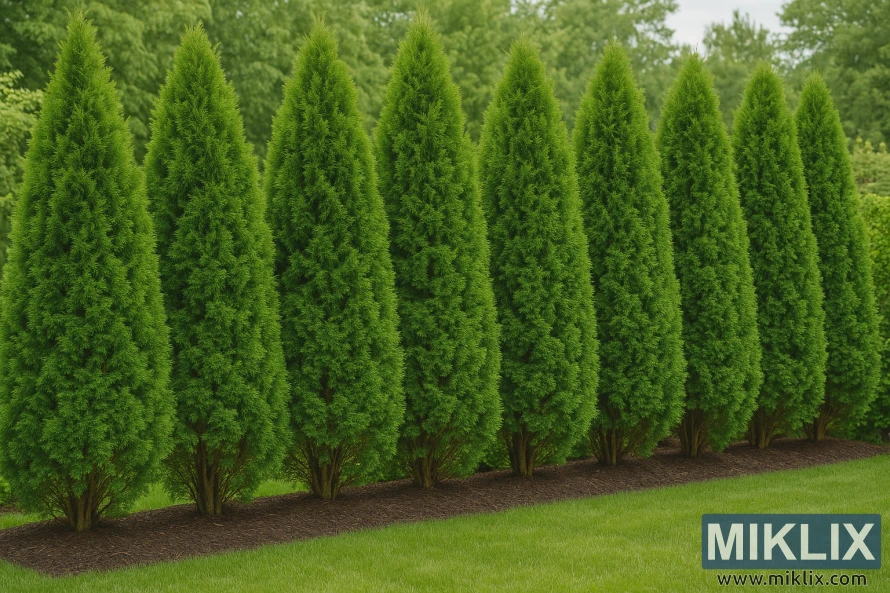Image: Arborvitae Hedge in Garden
Published: August 22, 2025 at 9:04:55 AM UTC
Last updated: September 28, 2025 at 11:16:51 AM UTC
A neatly arranged row of vibrant green Arborvitae trees creates a dense, elegant privacy screen in a serene garden with mulched soil and manicured lawn.
The image presents a beautifully cultivated garden scene, where a row of Arborvitae trees has been carefully planted and maintained to serve as both a practical and aesthetic feature. Standing tall and evenly spaced, each tree takes on a perfect conical form, its rich green foliage densely packed and featherlike in texture. Together, they create an unbroken wall of greenery, forming a living screen that combines privacy with elegance. This arrangement demonstrates not only the adaptability of Arborvitae as a garden choice but also the artistry of thoughtful landscaping, where structure, order, and natural beauty come together seamlessly.
The trees rise confidently from a well-prepared bed of dark mulch, their narrow trunks visible at the base. This mulch not only anchors the planting visually but also provides a practical function, helping to retain soil moisture, suppress weeds, and regulate temperature around the roots. The uniformity of the mulching and the clarity of the planting line suggest careful planning and meticulous upkeep, reinforcing the sense of refinement that defines this garden. In front of the Arborvitae, a broad sweep of velvety green lawn stretches outward, its immaculate surface echoing the precision of the planting. The bright tone of the grass contrasts gently with the deeper greens of the conifers, further enhancing their striking vertical forms.
Each Arborvitae appears to have been selected and nurtured to complement its neighbor, creating a consistent rhythm of height and proportion. The effect is one of both natural growth and disciplined design, as though the trees themselves have been sculpted into architectural columns. Their foliage, soft to the eye, seems to invite touch, yet remains dense enough to block views, confirming their role as guardians of privacy. The tightly interlaced greenery leaves little space between branches, ensuring that even in winter, when many other plants lie bare, this living wall would continue to provide coverage and visual interest.
Behind the main row, the blurred shapes of additional trees and shrubs add layers of depth to the composition. Their softer outlines emphasize the clarity and sharpness of the Arborvitae in the foreground, allowing them to dominate the scene. The background greenery also enhances the atmosphere of seclusion, suggesting that this garden might be set within a larger, wooded area or bordered by natural landscapes. The result is a tranquil and intimate outdoor space, where the noise of the outside world seems distant, replaced by the quiet presence of greenery.
The symmetrical arrangement of the Arborvitae reflects the human desire to create order within nature. Their vertical thrust draws the eye upward, symbolizing endurance and aspiration, while their collective presence offers reassurance, as though they stand together in solidarity, shielding the garden from intrusion. Their timeless formality lends itself well to both classical and contemporary garden styles, making them a versatile choice that transcends trends. Whether viewed from afar as a striking green wall or up close where individual textures and tones can be appreciated, these trees embody both utility and beauty.
In essence, this image captures the essence of Arborvitae as more than just trees—they are living design elements, harmonizing practicality with artistry. Their role as a natural privacy screen is undeniable, but their contribution to the atmosphere of the garden goes further, providing structure, rhythm, and serenity. By combining their evergreen resilience with careful landscaping, the scene illustrates how thoughtful planting can transform a space into a sanctuary, one where order and nature coexist gracefully.
The image is related to: A Guide to the Best Trees to Plant in Your Garden

